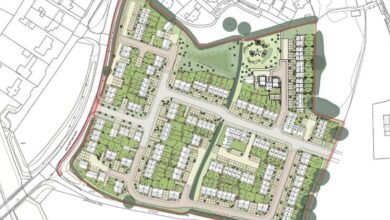A treasure hunt to make Minnesota property maps more accurate

On the boundary between Polk and Clearwater Counties in northwestern Minnesota, surveyors Garrett Borowicz and Brandon Carlson push through brush to inspect a large oak tree.
This tree is one of three ties or validation points for the survey monument buried a few inches beneath the surface of a nearby gravel road.
This is one of 6,580 original survey monuments in Polk County. However, only nine percent of those have verified coordinates in the geographic information system that’s used to draw digital maps.
That can create problems for people who depend on digital mapping apps to verify their property lines.
Gifts from individuals keep MPR News accessible to all – free of paywalls and barriers.

Surveyor Brandon Carlson establishes GPS coordinates for a location in rural Polk County.
Dan Gunderson | MPR News
“They all have it on their phone and they look at the property lines on there and then they think that’s where the property line is and it’s not always accurate,” said Borowicz. “It depends on where you’re at if the accuracy is good or not. This program will help make all those applications much more accurate.”
The original survey monuments were placed here in 1871 as survey teams laid out the one mile square grid that is the basis for all property lines in the state. Each square is called a section.
Much of the state was surveyed in the latter half of the 19th century, establishing the reference points for documenting land ownership as Europeans moved into the area. There are an estimated 300,000 monuments in Minnesota, according to a state official.
The monuments were often just a wooden stake pounded into the ground or were sometimes charred in a fire to slow decomposition.

Original surveyor notes are used to help verify the position of survey monuments placed more than 150 years ago.
Courtesy of the U.S. Bureau of Land Management
The original survey teams were equipped with a compass, a 66-foot measuring chain and remarkable stamina. Many were not trained surveyors. As they methodically moved through forests and swamps and clouds of mosquitos, their measurements often were not perfect. But under federal law they are considered to be “without error.”
Borowicz has found that in Polk County the monuments are more accurate in the areas that were flat native prairie, but there are disparities in the forested eastern part of the county. Inaccurate original measurements affect the land parcels.
“Your 80-acre piece of property is going to be based off of the original surveys,” said Borowicz “If a surveyor came out today and did measurements around a section, that 80 acres could be 78.9 acres, it could be 82 acres.”

Surveyor Garrett Borowicz keeps two original survey monuments more than a century old in his office as a reminder of the work done by the surveyors who first measured Minnesota. The wooden stakes were often charred to make them more resistant to rotting.
Dan Gunderson | MPR News
State Sen. Steve Green, R-Fosston, has raised concerns about the project, saying in a Facebook post he is hearing from landowners who are concerned property lines will be changed.
In an interview, Green clarified that he supports the re-monumentation project.
“My concern is that we want to make sure that people who own the property are involved in this so that they don’t move monuments, that they actually go back and find the original monuments,” Green said.
Kory Thurnau with the Minnesota Geospatial Information Office said this project will not change any property boundaries.

Surveyor Brandon Carlson (right) and local resident Doyle Erickson talk about the location of a survey monument. Erickson supports the project because it will reduce his cost for land surveys in the future.
Dan Gunderson | MPR News
“It isn’t that we’re going out there to correct the measurements that those original surveyors should have been making,” explained Thurnau, who is overseeing the statewide project. “They used the best technology they had at the time, we’re coming in and using technology of our day, but we’re to follow in their footsteps and put those section corners back where they were originally located.”
The goal is to provide GPS coordinates for every original monument, so digital mapping applications more accurately reflect the land grid created 150 years ago, errors included.
Finding the original monuments is not a simple process. Garrett Borowicz works with fellow surveyor Brandon Carlson for Widseth Smith Nolting & Associates in Crookston. He spends weeks poring over old documents, including the original surveyor’s notes written in the fancy but nearly illegible cursive script of the 1800’s. He also looks through road and ditch records, since those were often built along the original survey lines.
He likens it to a treasure hunt.
“You’re doing all your research to come up with that conclusion,” he said. “It’s a fun process, it’s challenging and fun at the same time.”
All of that historical research happens before surveyors go into the field.

Surveyor Garrett Borowicz spends days poring over historical records to help establish the exact location of 150 year old survey markers in Polk County.
Dan Gunderson | MPR News
Brandon Carlson does much of the field work for this grant. He carries thousands of dollars’ worth of precision measuring gear, but he still faces some of the same challenges as the original surveyors.
“You’ve got to walk in a mile or two to get to them. Some of them are pretty tough,” Carlson said. He’s had to wade through swamps and bushwhack through dense willow thickets, while fending off mosquitos and ticks.
Still, Carlson enjoys the time outside and the challenge of finding and documenting each marker.
After a monument is found and coordinates established, it must be certified to update the history of these important points on the landscape.
It’s slow, tedious work. Sixty-five counties requested grants and 34 were awarded a piece of the $9.1 million available to start the work this year. Counties are responsible for maintaining the land survey system, and some counties have done significant work to update the system already, but cost has limited the work in many parts of the state.

Surveyor Brandon Carlson writes surveyors notes for a monument site in rural Polk County on July 18, 2024. They will become part of the public record for this monument.
Dan Gunderson | MPR News
Completing the project will likely take years, or even decades, and cost an estimated $350 million.
But updating the critical Public Land Survey System, infrastructure will pay dividends far into the future said Alison Slaats, Minnesota’s chief geospatial information officer.
“GIS is a representation of the real world, whereas PLSS corner’s are actually out in the real world,” she said. “So, what we see on digital maps or computer mapping is a representation of the world and we try and do our best to accurately represent the real world so that we can use the data to make informed decisions.”
Source link





